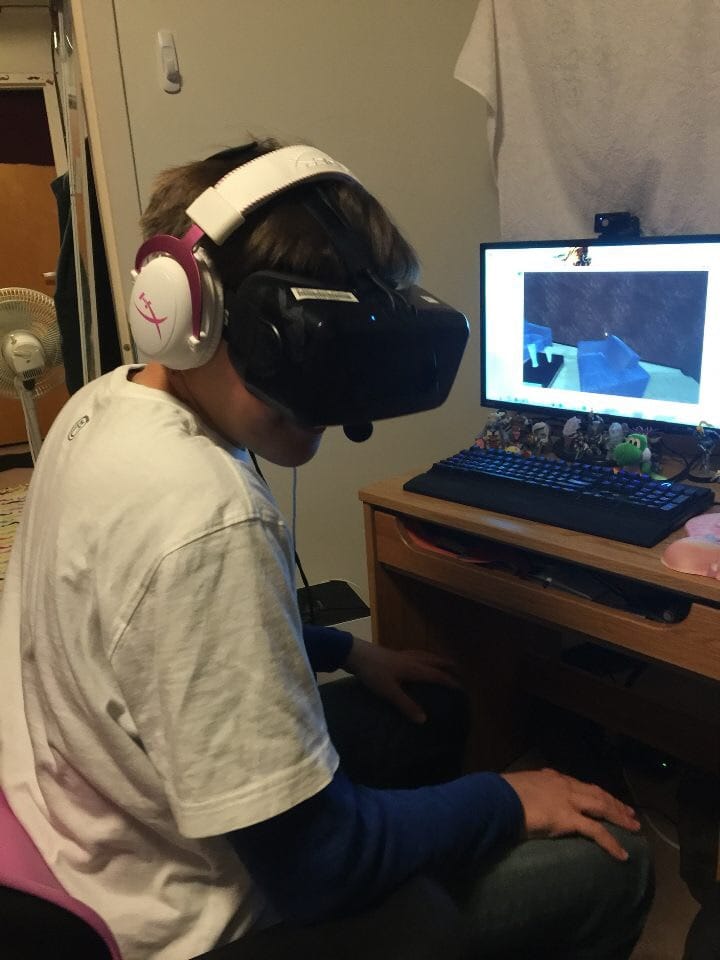The Power of Virtual Reality: Hands On With the Oculus Rift

It didn’t look like much, a hunk of plastic that could vaguely resemble the shape of a visor. However, I knew its reputation. I had heard the whispers and read the online impressions. People were saying that it would change everything, but I was doubtful. Little did I know that the Oculus Rift would live up to the promise of an immersive virtual reality experience.
For those unaware, the Oculus Rift is one of the major virtual reality headsets on the market today. The idea is that one only has to slip it on to be transported to an entirely different reality. The Rift I was using belonged to Melissa Billing ’18, who had acquired it as part of a project. It was the Developer’s Kit 2 version of the Oculus Rift, and she was quick to tell me that the final consumer version of the product was far more comfortable and streamlined than the version I would be using. After a few minutes of set up, I took a seat and put on the Oculus Rift. I’ll take a moment to go over some quick technical gripes I have with the Rift. For one thing, the copious amounts of cables meant that I would sometimes get tangled up while I was moving my head around. Additionally, the Oculus is purely visual, so I also had to put on a pair of headphones as well, which only added another cable.
I sat in the darkness for a few seconds while Billing selected one of the demos she had downloaded and attached a small leap motion sensor to the Rift. Eventually, I saw a small gray rectangle appear before me with a big smiley face, asking me to make a thumbs-up motion, which is picked up by the sensor. When I did so, the floor around me lit up in a grid while my new friend taught me how to interact with my surroundings. I could make 3-D shapes by pinching my figures and manipulated them just by reaching out and grabbing them. It was immersive enough that I accidentally bumped my hands into Billing’s desk a couple of times. I began to experiment by creating towers and attempting to juggle, and I can say that the physics all held up pretty well. I was told that I could control gravity and I immediately set out on recreating a small meteor shower. There was something truly special about sitting there and deactivating gravity, causing dozens of tiny stars to come crashing to earth all around me.
After the demo, I sat down with Billing for a moment to talk to her about the Oculus Rift and about her project, “Virtual Reality for Virtually Everybody.”
“I am working with Professor Marisa Parham and others on this project and our goal is to make virtual reality more accessible,” Billing said. “We’re trying to create small tools and demos so that educators and others who may not know about virtual reality can see how valuable the technology is. We want educators to create brand new content for their classrooms. Imagine taking a classroom on a field trip throughout the solar system or to a historical battlefield. Rather than seeing a picture in textbooks, you can be right there for a hands on experience. VR also has some pretty obvious applications for healthcare, video games and even more. The more people we have working on it, the better it will be in the end. After all, it’s incredibly hard to tell people how amazing VR can be just by explaining it or by showing screenshots. You need to experience it firsthand.”
As the lights come on, I flinched in fear as an armored soldier flew past my head. I found myself slowly moving along a city street where other soldiers were in a firefight with a heavily armed giant robot. The action was in slow motion as I floated along, to the point where I could track the ripples that the bullets made in the air as the soldiers shot at their attacker. In response, the robot fired another explosive that slammed into a nearby building, showering debris all along the street. While the men took cover and dove out of the way, I weaved through pieces of rubble as large as myself.
Another rocket was fired, this time hitting a nearby car. As I watched the shockwave of the blast smack away nearby objects, the car soared into the air in an arc, passing directly above my head. I took a peek in the window as it flew past and I noticed the unfortunate driver still strapped in by his seat belt. As I returned my focus to the action, I suddenly realized how close I was getting to the giant war machine. With just a few feet between us, I watched as the robot slowly lifted one of its legs into the air. Suddenly, the action reverted to real time and I leapt in my seat as the robot moved with lightning speed and roared directly into my face.
Needless to say, I agree with Billing 100 percent. It is incredibly difficult to put into words just how much potential this technology has because it has to be experienced to be fully understood. Never before had I ever experienced this kind of immersion. I am now living in eager anticipation to see how teachers, filmmakers, doctors and more will take advantage of this kind of technology. For years, I had considered virtual reality a science fiction, something that could never be practically implemented. I was wrong. VR is here and it is very, very real.





Comments ()